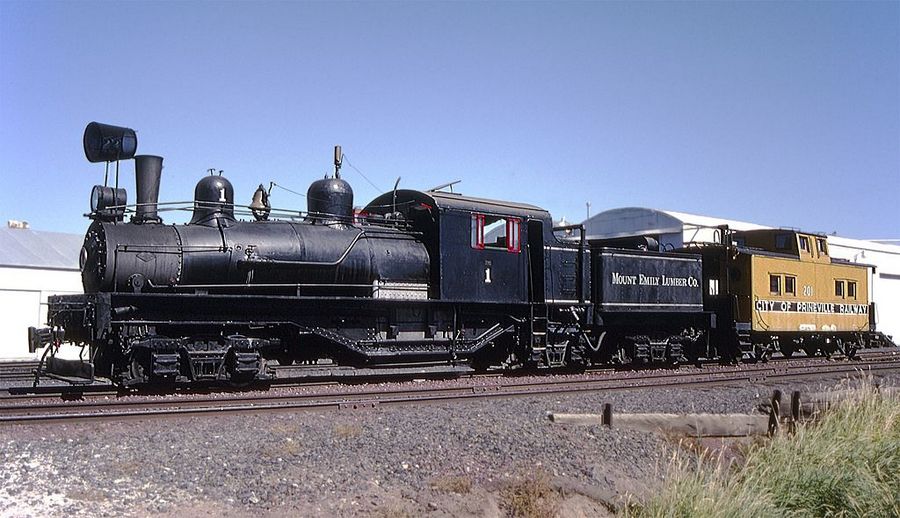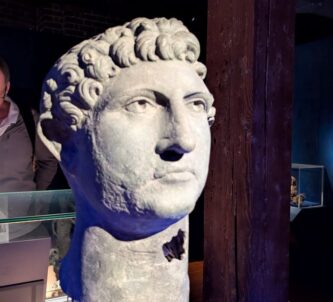The 100-year-old American steam logging locomotive, Mount Emily Shay No.1, travelled by flatcar to its new home, the Oregon Rail Heritage Center, on Thursday (15 Feb).
The historic locomotive had been in the care of the Oregon Historical Society (OHS) for more than six decades when, in 2022, OHS chose to transfer the Shay to the Oregon Rail Heritage Foundation to be its permanent owner.
The design concept of these logging and mining locomotives is fascinating.“We are grateful to OHS and thrilled to be the new operators of the Mount Emily Shay #1,” said Rick Franklin, president of the Oregon Rail Heritage Foundation. “We look forward to entertaining and educating Oregonians of all ages on excursions powered by this grand old lady of Oregon railroading history.”
The Mount Emily Shay #1 was built in 1923 by the Lima Locomotive Works in Ohio from a design by Ephraim Shay. Shays were geared workhorses of the timber and mining industries. After five years with the Independence Logging Company in Aberdeen, Washington, the Shay was sold to the new Mount Emily Lumber Company in LaGrande, Oregon.
The design concept of these logging and mining locomotives is fascinating. The Shays were powerful geared locomotives designed to haul heavy loads in hill and mountain territory where tracks are liable to be steep and tightly curved. Instead of the traditional rod system connecting wheels to a central engine, Shay locomotives had gear drives. Two or three vertical cylinders drove longitudinal driveshafts connected to gears on each set of bogies. This gave them excellent traction on steep grades and uneven tracks, and the bogies, rather than a set of traditional fixed drive wheels, were better able to handle tight curves*.
Look at the way these driveshafts work through a set of universal joints and expanding square rods on the right hand side of the loco…
Key Features of Mount Emily Shay:
- Three-bogie configuration: This offered better stability and weight distribution compared to two-bogie models.
- Lima Shay construction: It was built by the Lima Locomotive Works, known for their robust Shay designs.
- Regular fire-tube boiler: This boiler type was commonly used on steam locomotives and provided efficient heat transfer.
- Offset boiler: The boiler was positioned to the left to accommodate the “motor” on the right side.
- Vertical cylinders: Three cylinders provided significant power for hauling heavy loads.
- Universal joints and sliding joints: These allowed for the driveshafts to flex as the trucks swivelled on curves.
There were some drawbacks to the design. The complex geared system required more maintenance compared to traditional designs, and geared locomotives generally had lower top speeds than rod-driven ones. In addition they tended to consume more fuel compared to some other designs.
In 1955, at the end of her working life, the Mount Emily timber company shut its rail operations and donated Shay #1 to the Oregon Museum of Science and Industry (OMSI), then located in Washington Park. OMSI concluded the locomotive was too big for the Vista Ridge tunnel and so, in 1958, donated the engine to the Oregon Historical Society. In the 1970s the Shay went on long-term loan to the state of West Virginia, where she was restored to working order and operated on the Cass Scenic Railroad.

In 1994, the Oregon Historical Society recalled the locomotive back to Oregon to be housed and operated in the City of Prineville, where she remained for almost three decades. In 2021 Prineville Railway requested an end to the loan agreement, and since OHS is not equipped to house nor operate a locomotive, the organisation sought a new steward. The Oregon Rail Heritage Foundation was selected to be the new owner of the Mount Emily Shay in September 2022. The locomotive will now be on display at the foundation’s center, and after a boiler inspection, will used for excursions along the Willamette River.
Here in Europe we have nothing like the Mount Emily Shay’s unique geared design because our logging terrain is generally less challenging and we had stricter standardization and weight restrictions. However, there were some engines with similar functionalities, but different approaches…
- Meyer Locomotives: Articulated steam locomotives developed in Germany, with multiple powered axles, achieving good traction without using gears.
- SLM Locomotives: Swiss engines made in Winterthur that used rack-and-pinion systems for steep inclines, offering alternative traction methods.
- Fairlie Locomotives: These British designs had boilers mounted between two sets of driving wheels, achieving flexibility like Shays but using rods instead of gears.
The closest equivalent were Heisler Locomotives, which were geared like Shays but less common. They were operated mainly in Austria and Switzerland.
So, if you are visiting the Portland area, you should grab the opportunity to visit the Oregon Rail Heritage Center and see the extraordinary Mount Emily Shay. Admission is free to the public during open hours, Thursday-Sunday 1-5 pm. Train excursions along the Willamette River in Portland are offered on many Saturdays year-round and more frequently during the year-end holidays.
* In the UK, we tended to use small narrow gauge locomotives to get around those curves.







